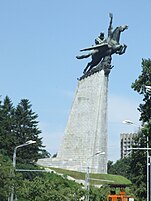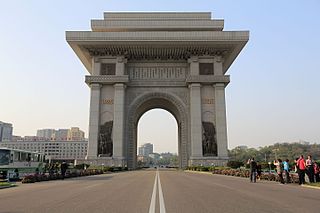
Pyongyang is the capital and largest city of the Democratic People's Republic of Korea (DPRK), commonly known as North Korea, where it is sometimes labeled as the "Capital of the Revolution". Pyongyang is located on the Taedong River about 109 km (68 mi) upstream from its mouth on the Yellow Sea. According to the 2008 population census, it has a population of 3,255,288. Pyongyang is a directly administered city with a status equal to that of the North Korean provinces.
The music of North Korea includes a wide array of folk, popular, light instrumental, political, and classical performers. Beyond patriotic and political music, popular music groups like Pochonbo Electronic Ensemble and Moranbong Band perform songs about everyday life in the DPRK and modern light pop reinterpretations of classic Korean folk music. Music education is widely taught in schools, with President Kim Il Sung first implementing a program of study of musical instruments in 1949 at an orphanage in Mangyongdae. Musical diplomacy also continues to be relevant to the Democratic People's Republic of Korea, with musical and cultural delegations completing concerts in China and France in recent years, and musicians from Western countries and South Korea collaborating on projects in the DPRK.

The Taedong River (Korean: 대동강) is a large river in North Korea. The river rises in the Rangrim Mountains of the country's north where it then flows southwest into Korea Bay at Namp'o. In between, it runs through the country's capital, Pyongyang. Along the river are landmarks such as the Juche Tower and Kim Il-sung Square.
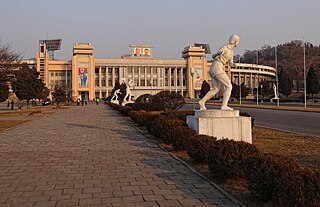
Kim Il Sung Stadium (Korean: 김일성경기장) is a multi-purpose stadium located in Pyongyang, the capital city of North Korea. The stadium is used primarily for association football matches.

Moranbong or Moran Hill forms a park located in central Pyongyang, the capital of North Korea. Its 312-foot (95 m) summit is the location of the Pyongyang TV Tower.

The Kumsusan Palace of the Sun, formerly the Kumsusan Memorial Palace (금수산기념궁전), is a building near the northeast corner of the city of Pyongyang that serves as the mausoleum for Kim Il Sung, the founder of North Korea, and for his son Kim Jong Il, both posthumously designated as the Eternal leaders of North Korea.

Moranbong-guyŏk (Korean: 모란봉구역), or the Moranbong District, is one of the 18 guyŏk which constitute the capital city of Pyongyang, North Korea. It is located north of Chung-guyok, the city's central district, and is bordered to the north by Sosong and Taesong-guyoks, to the east by the Taedong River, and the west by the Pothonggang Canal and Potonggang-guyok. It is named after Moran Hill, located in the district's west area – Moran. It was designated a guyŏk in October 1960 by the Pyongyang City People's Committee.

The Mansudae Art Studio is an art studio in Pyeongcheon District, Pyongyang, North Korea. It was founded in 1959, and it is one of the largest centers of art production in the world, at an area of over 120,000 square meters. The studio employs around 4,000 people, 1,000 of whom are artists picked from the best academies in North Korea. Most of its artists are graduates of Pyongyang University. The studio consists of 13 groups, including those for woodcuts, charcoal drawings, ceramics, embroidery and jewel paintings, among other things.

The Rungra Bridge is a bridge in Pyongyang, North Korea, one of the city's six bridges on the Taedong River. Located between the Okryu Bridge to the south and Chongryu Bridge to the north, it connects Moranbong-guyok on the right (west) bank of the Taedong River with Taedonggang-guyok on the left bank, passing through Rungra Island in the middle. It totals 1,070 metres (3,510 ft) in length. It was completed in 1988.

The Mangyongdae Children's Palace in Pyongyang is a public facility managed by Korean Youth Corps in North Korea where pioneer members can engage in extra-curricular activities, such as learning music, foreign languages, computing skills and sports. It was established on 2 May 1989 and it is situated in Kwangbok (Liberation) Street, in the north of Mangyongdae-guyok. It is the largest of the palaces in North Korea dedicated to children's after-school activities. In front of the Children's Palace there are a grand sculpture group and two enormous fountains, rising 90 and 100 metres.

Mangyongdae (Korean: 만경대) is a neighborhood in Mangyongdae-guyok, Pyongyang, North Korea. North Korean propaganda claims Mangyongdae is the birthplace of North Korean leader Kim Il Sung, although in his memoirs he wrote that he had been born in the nearby neighborhood of Chilgol. Mangyongdae is where his father Kim Hyong-jik was from, and where Kim Il Sung spent his childhood.

The Mansu Hill Grand Monument is a complex of monuments in Pyongyang, North Korea. There are 229 figures in all, commemorating the history of the revolutionary struggle of the Korean people, and especially their leaders. The central part of the monument consists of two 22-meter-tall (72 ft) bronze statues of Kim Il Sung and Kim Jong Il.

The Day of the Sun is an annual public holiday in North Korea on 15 April, the birth anniversary of Kim Il Sung, founder and Eternal President of North Korea. It is the most important national holiday in the country, and is considered to be the North Korean equivalent of Christmas. Kim's birthday, which had been an official holiday since 1968, was renamed Day of the Sun in 1997, three years after his death. The name takes its significance from his name: Il-sung.
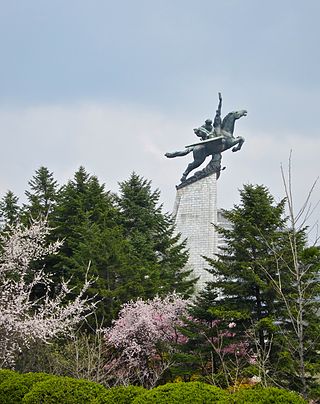
The Chollima Statue (Korean: 천리마동상) is a monument on Mansu Hill in Pyongyang, the capital of North Korea. The monument symbolizes the "Chollima speed" of the Chollima Movement. The legendary winged horse Chollima depicted by the monument is said to travel 1,000 ri (400 km) a day.

The April 25 House of Culture is a theatre located in Pyongyang, North Korea. It was built in 1974–1975 to provide a venue for military education, and was originally called the February 8 House of Culture. It is located on Pipha Street in the Moranbong District of Pyongyang. The classically colonnaded building is considered one of the best examples of 1970s socialist monumentality in North Korea, the other being the visually similar Mansudae Art Theatre.

The Samjiyon Band is a North Korean classical music ensemble.
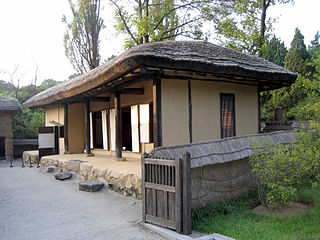
Revolutionary Sites (Korean: 혁명사적지) are designated historical sites in North Korea. The sites were designated by Kim Jong Il when he began working at the Propaganda and Agitation Department of the Workers' Party of Korea in 1966. He would send troops all over the country to unearth sites that "were supposedly once forgotten and undiscovered". By converting North Korea into a "huge open museum", Kim's goal in designating the sites was to solidify the North Korean cult of personality centered around him and his father Kim Il Sung.
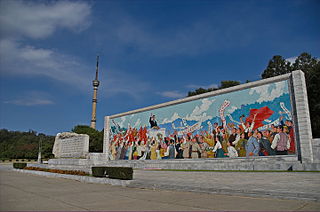
Kaeson Revolutionary Site (개선혁명사적지) is a Revolutionary Site in Pyongyang. It marks the spot near Kim Il Sung Stadium where Kim Il Sung delivered his victory speech after the liberation of Korea on 14 October 1945, entitled "Every Effort for the Building of a New Democratic Korea". At that time, the place was called the Pyongyang Public Ground (평양공설운동장). There is a mural depicting the scene at the site. A quotation from the speech is carved in stone reads: "To contribute positively to the work of building the state, let those with strength give strength, let those with knowledge give knowledge, let those with money give money". The site is located in the Moranbong area, west of the hill of the same name.

Chilgol (Korean: 칠골) is a suburb of Pyongyang in the Mangyongdae District.

